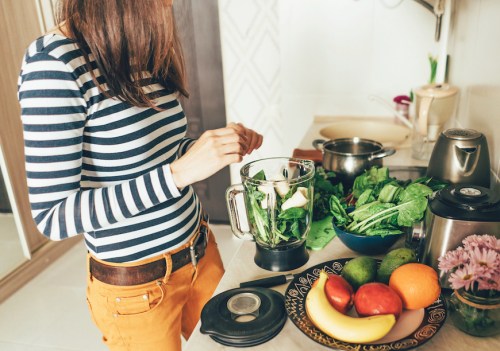Experimenting with smoothie-making is a right of passage for the wellness curious. Some people get super into it and the blender becomes their most beloved kitchen tool, used every morning for breakfast or afternoon for post-workout fuel. For others…not so much. Their blender gets put out of reach so there’s more space on the kitchen counter for their Instant Pot or air fryer, with the blender only pulled out on special occassions.
However often you fire up your blender, chances are that you’ve come across the common problem of your smoothie just not being as filling or satisfying as a meal. For some, that’s literally the reason why their blender was banished from the kitchen counter in the first place. According to Right Balance Nutrition founder and registered dietitian Jen Laurence, RD (who, full disclosure, is also my aunt), smoothies can be a nutritious, satiating meal replacement if you structure them like a meal, which she says many people don’t do.
“When I ask people how they make their smoothies, some tell me that they put in a whole banana, a cup of berries, an apple, and other foods, which is not how they would set up their plate,” Laurence says. “The key is to structure your smoothie like you would a plate.” Basically, if it doesn’t contain the normal nutritional elements of a lunch or dinner, there’s no way it’s going to be as satisfying as a meal on its own.
Here, Laurence explains exactly what what to put in your smoothie in order to ensure it’s close to how you would set up a plate, including her four-step formula for making a smoothie that’s healthy, delicious, and satisfying. Tall order, but she delivers the goods.
What to put in a smoothie to make it as filling as a meal:
1. complex carbs
Surprised? *This* is the nutrient Laurence says many people forget to include in their smoothies. Complex carbohydrates are basically foods that contain long, “complex” sugar molecule chains that are more slowly digested by the body, which is crucial for satiety. “Without a serving of complex carbs, you’re going to be hungry within an hour or so of having your smoothie,” she says. “Complex carbs also help keep blood sugar levels from spiking,” she says, which helps keep energy and mood stable. Oats (not to be confused with oat milk, which is mostly made of water) are one of her favorite complex carbs to add to her smoothies. “You could also use a [whole] grain, like quinoa or amaranth,” she says.
2. protein
You wouldn’t look at a plate of greens and fruit and think of it as a satisfying lunch; same goes for smoothies. Laurence says protein is definitely a must in terms of making a smoothie that can give you energy and fill you up. “If you’re having a smoothie for a meal, you want the protein to be between 10 and 20 grams,” she says. “This can come in the form of Greek yogurt, flaxseeds, chia seeds, or a scoop of protein powder.”
3. Fiber
Laurence says it’s important to load up on vegetables at every meal because they’re full of fiber (good for digestive health, blood sugar levels, and satiety) and phytonutrients; the same rationale applies to making a smoothie. “This is going to provide you with the fiber that will keep you full longer,” she says. For her, spinach is typically her go-to, or she’ll opt for carrots when she’s in the mood for something a little sweeter. Fruit (such as a cup of berries) is also a good source of fiber and antioxidants, Laurence adds.
4. healthy fats
Healthy fats are crucial for brain, hormonal, and heart health, which is why it’s important to get a serving at every meal. What’s tricky about smoothie building is that some foods, like peanut butter, are sources of both protein and healthy fats. “Some foods are confusing because they’re both, so in these cases, I recommend looking at what macronutrient makes up the majority of the food,” Laurence says. “For example, with peanut butter, it has protein, but it’s mostly made of healthy fats.” So while typically a person only needs about 14 grams per meal, that number often is included in what’s coming from your protein source. (TL;DR: You don’t need to add a ton of extra fat in most cases.) Think a quarter of an avocado or a quarter-cup of nuts.
Listed out like this, it can seem like a lot goes into making a healthy smoothie, but Laurence reiterates that most foods contain more than one nutrient, helping fill different nutrient buckets at the same time. (Fruits and veggies, for example, also contain some carbs.) The main key it to make sure you’re hitting each of the four nutrients—including those oft-neglected complex carbs. With these tips in mind, maybe you’ll become a smoothie person after all.
Sign Up for Our Daily Newsletter
Get all the latest in wellness, trends, food, fitness, beauty, and more delivered right to your inbox.
Got it, you've been added to our email list.











